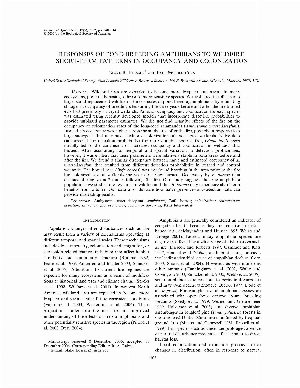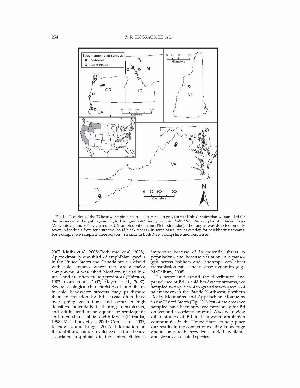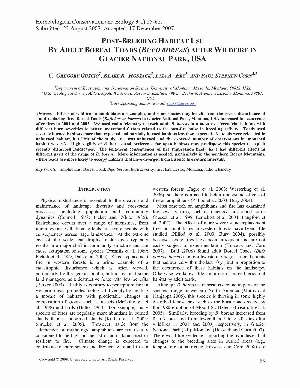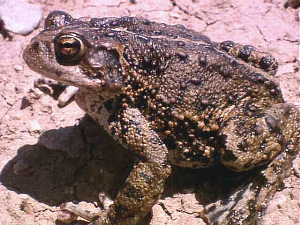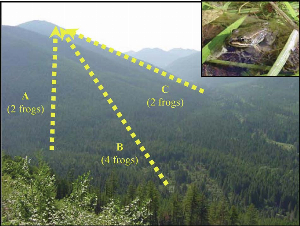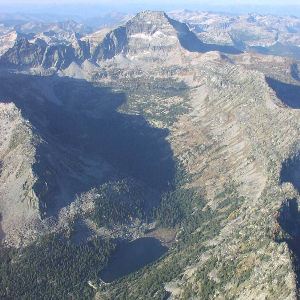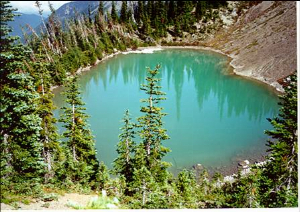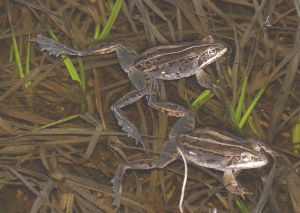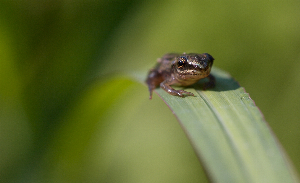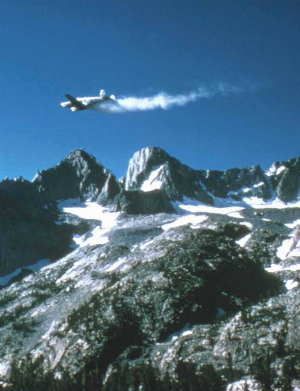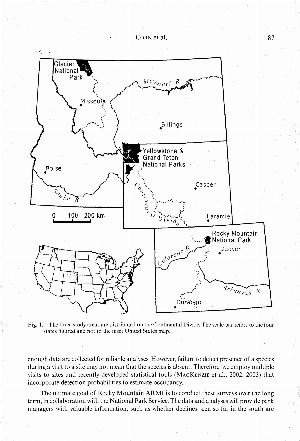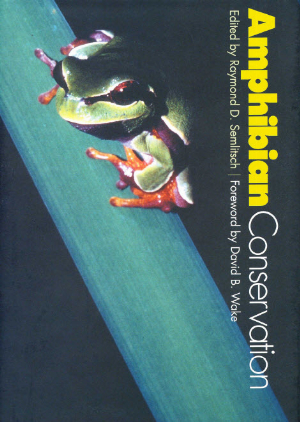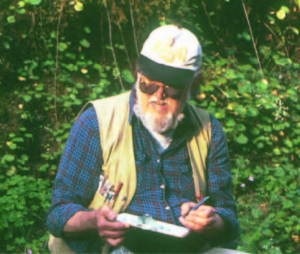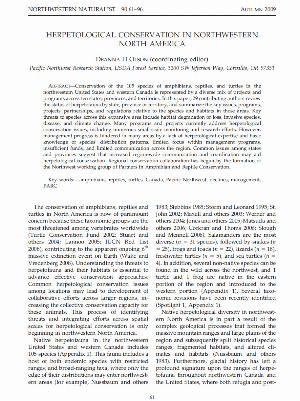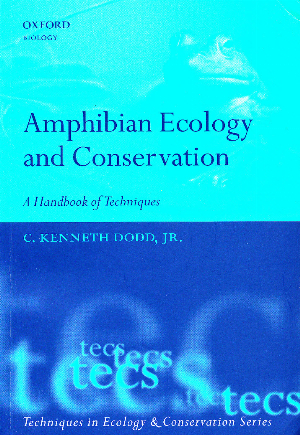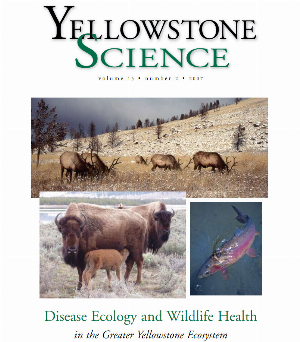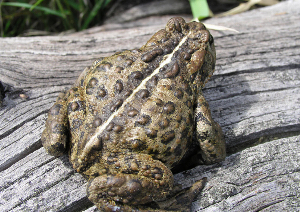Search ARMI Database
Search term(s)
Contribution Number
Search Results
70 record(s) found.
Papers & Reports Responses of pond-breeding amphibians to wildfire: short-term patterns in occupancy and colonization
Authors: Blake R Hossack; P. Stephen Corn
Date: 2007 | Outlet: Ecological Applications 17: 1403–1410
Wildland fires are expected to become more frequent and severe in many ecosystems, potentially posing a threat to many sensitive species. We evaluated the effects of a large, stand-replacement wildfire on three species of pond-breeding amphibians by estimating changes in occupancy of breeding sites during the three years before and after the fire burned 42 of 83 previously surveyed wetlands. Annual occupancy and colonization for each species was estimated using recently developed models that incorporate detection probabilities to provide unbiased parameter estimates. We did not find negative effects of the fire on the occupancy or colonization rates of the long-toed salamander (Ambystoma macrodactylum). Instead, its occupancy was higher across the study area after the fire, possibly in response to a large snowpack that may have facilitated colonization of unoccupied wetlands. Naive data (uncorrected for detection probability) for the Columbia spotted frog (Rana luteiventris) initially led to the conclusion of increased occupancy and colonization in wetlands that burned. After accounting for temporal and spatial variation in detection probabilities, however, it was evident that these parameters were relatively stable in both areas before and after the fire. We found a similar discrepancy between naive and estimated occupancy of A. macrodactylum that resulted from different detection probabilities in burned and control wetlands. The boreal toad (Bufo boreas) was not found breeding in the area prior to the fire but colonized several wetlands the year after they burned. Occupancy by B. boreas then declined during years 2 and 3 following the fire. Our study suggests that the amphibian populations we studied are resistant to wildfire and that B. boreas may experience short-term benefits from wildfire. Our data also illustrate how naive presence–non-detection data can provide misleading results.
Papers & Reports Low prevalence of chytrid fungus (Batrachochytrium dendrobatidis) in U. S. headwater amphibians
Authors: Blake R Hossack; Michael J Adams; Evan HC Grant; Christopher A Pearl; Jamie Bettaso; William J Barichivich; W H Lowe; K True; J L Ware; P. Stephen Corn
Date: 2010-06-01 | Outlet: Journal of Herpetology 52: in press
Many declines of amphibian populations have been associated with chytridiomycosis, a disease caused by the aquatic fungus Batrachochytrium dendrobatidis (Bd). Despite the relatively high prevalence of chytridiomycosis in stream amphibians globally, most surveys in North America have focused primarily on wetland-associated species, which are frequently infected. To better understand the distribution and prevalence of Bd in headwater amphibian communities, we sampled 452 tailed frogs (Ascaphus truei and Ascaphus montanus) and 304 stream salamanders (seven species in the Dicamptodontidae and Plethodontidae) for Bd in 38, first- to third-order streams in five montane areas across the United States. We tested for presence of Bd by using PCR on skin swabs from salamanders and metamorphosed tailed frogs or the oral disc of frog larvae. We detected Bd on only seven individuals (0.93%) in four streams. Based on our study and results from five other studies that have sampled headwater- or seep-associated amphibians in the United States, Bd has been detected on only 3% of 1,322 individuals from 21 species. These results differ strongly from surveys in Central America and Australia, where Bd is more prevalent on stream-breeding species, as well as results from wetland-associated anurans in the same regions of the United States that we sampled. Differences in the prevalence of Bd between stream- and wetland-associated amphibians in the United States may be related to species-specific variation in susceptibility to chytridiomycosis or habitat differences.
Papers & Reports Post-breeding habitat use by adult boreal toads (Bufo boreas boreas) after wildfire in Glacier National Park, USA
Authors: C G Guscio; Blake R Hossack; Lisa A Eby; P. Stephen Corn
Date: 2008 | Outlet: Herpetological Conservation and Biology 3: 55–62
Effects of wildfire on amphibians are complex, and some species may benefit from the severe disturbance of stand-replacing fire. Boreal Toads (Bufo boreas boreas) in Glacier National Park, Montana, USA increased in occurrence after fires in 2001 and 2003. We used radio telemetry to track adult B. boreas in a mosaic of terrestrial habitats with different burn severities to better understand factors related to the post-fire pulse in breeding activity. Toads used severely burned habitats more than expected and partially burned habitats less than expected. No toads were relocated in unburned habitat, but little of the study area was unburned and the expected number of observations in unburned habitat was < 3. High vagility of B. boreas and preference for open habitats may predispose this species to exploit recently disturbed landscapes. The long-term consequences of fire suppression likely have had different effects in different parts of the range of B. boreas. More information is needed, particularly in the northern Rocky Mountains, where toads are more likely to occupy habitats that have diverged from historic fire return intervals.
Papers & Reports Mitochondrial DNA evolution in the Anaxyrus boreas species group
Authors: A M Goebel; T A Ranker; P. Stephen Corn; R G Olmstead
Date: 2009 | Outlet: Molecular Phylogenetics and Evolution 50: 209–225
The Anaxyrus boreas species group currently comprises four species in western North America including the broadly distributed A. boreas, and three localized species, Anaxyrus nelsoni, Anaxyrus exsul and Anaxyrus canorus. Phylogenetic analyses of the mtDNA 12S rDNA, cytochrome oxidase I, control region, and restriction sites data, identified three major haplotype clades. The Northwest clade (NW) includes both subspecies of A. boreas and divergent minor clades in the middle Rocky Mountains, coastal, and central regions of the west and Pacific Northwest. The Southwest (SW) clade includes A. exsul, A. nelsoni, and minor clades in southern California. Anaxyrus canorus, previously identified as paraphyletic, has populations in both the NW and SW major clades. The Eastern major clade (E) includes three divergent lineages from southern Utah, the southern Rocky Mountains, and north of the Great Basin at the border of Utah and Nevada. These results identify new genetic variation in the eastern portion of the toad’s range and are consistent with previous regional studies from the west coast. Low levels of control region sequence divergence between major clades (2.2–4.7% uncorrected pair-wise distances) are consistent with Pleistocene divergence and suggest that the phylogeographic history of the group was heavily influenced by dynamic Pleistocene glacial and climatic changes, and especially pluvial changes, in western North America. Results reported here may impact conservation plans in that the current taxonomy does not reflect the diversity in the group.
Papers & Reports High dispersal in a frog species suggests that it is vulnerable to habitat fragmentation
Authors: W C Funk; A E Greene; P. Stephen Corn; Fred W Allendorf
Date: 2005 | Outlet: Biology Letters 1: 13–16
We examined dispersal rates in Columbia spotted frogs (Rana luteiventris) using capture–recapture analysis of over 10,000 frogs in combination with genetic analysis of microsatellite loci in replicate basins. We found that frogs had exceptionally high juvenile dispersal rates over long distances, large elevation gains and steep inclines that were corroborated by genetic data showing high gene flow.
Papers & Reports Population structure of Columbia spotted frogs (Rana luteiventris) is strongly affected by the landscape
Authors: W C Funk; Michael S Blouin; P. Stephen Corn; B A Maxell; David S Pilliod; Stephen J Amish; Fred W Allendorf
Date: 2005 | Outlet: Molecular Ecology 14: 483–496
Landscape features such as mountains, rivers, and ecological gradients may strongly affect patterns of dispersal and gene flow among populations and thereby shape population dynamics and evolutionary trajectories. The landscape may have a particularly strong effect on patterns of dispersal and gene flow in amphibians because amphibians are thought to have poor dispersal abilities. We examined genetic variation at six microsatellite loci in Columbia spotted frogs (Rana luteiventris) from 28 breeding ponds in western Montana and Idaho, USA, to investigate the effects of landscape structure on patterns of gene flow.
Papers & Reports Estimated ultraviolet radiation doses in wetlands in six national parks
Authors: S Diamond; P Trenham; Michael J Adams; Blake R Hossack; Roland A Knapp; S L Stark; David F Bradford; P. Stephen Corn; K Czarnowski; Paul D Brooks; D Fagre; Bob Breen; N E Detenbeck; K A Tonnessen
Date: 2005-07-31 | Outlet: Ecosystems 8: 462–477
Ultraviolet-B radiation (UV-B, 280 nm to 320 nm wavelengths) doses were estimated for 1024 wetlands in six National Parks; Acadia (Acadia), Glacier (Glacier), Great Smoky Mountains (Smoky), Olympic (Olympic), Rocky Mountain (Rocky), and Sequoia/Kings Canyon (Sequoia/Kings). Estimates were made using ground-based UV-B data (Brewer spectrophotometers), solar radiation models, GIS tools, field characterization of vegetative features, and quantification of DOC concentration and spectral absorbance. UV-B dose estimates were made for the summer solstice, at a depth of 1 cm in each wetland. Mean dose across all wetlands and parks was 19.3 Whr*m-2 (range of 3.4 to 32.1 Whr*m-2). Mean dose was lowest in Acadia (13.7 Whr*m-2) and highest in Rocky (24.4 Whr*m-2). Doses were significantly different among all parks. These wetland doses correspond to UV-B flux of 125.0 W*cm-2 (range of 21.4 to 194.7 W*cm-2) based on a day length, averaged among all parks, of 15.5 hr. Dissolved organic carbon (DOC), a key determinant of subsurface UV-B flux, ranged from 0.6 (analytical detection limit) to 36.7 mg carbon * l-1 over all wetlands and parks, and reduced potential maximal UV-B doses at 1 cm depth by 1 to 87 %. DOC concentration, as well as its effect on dose, was lowest in Sequoia/Kings, and highest in Acadia (DOC was equivalent in Acadia, Glacier, and Rocky). Landscape reduction of potential maximal UV-B doses ranged from zero to 77 %, and was lowest in Sequoia/Kings. These regional differences in UV-B wetland dose illustrate the importance of considering all aspects of exposure in evaluating the potential impact of UV-B on aquatic organisms.
Papers & Reports A comparison in Colorado of three methods to monitor breeding amphibians
Authors: P. Stephen Corn; Erin Muths; W M Iko
Date: 2000 | Outlet: Northwestern Naturalist 81: 22–30.
We surveyed amphibians at 4 montane and 2 plains lentic sites in northern Colorado using 3 techniques: standardized call surveys, automated recording devices (frog-loggers), and intensive surveys including capture-recapture techniques. Amphibians were observed at 5 sites. Species richness varied from 0 to 4 species at each site. Richness scores, the sums of species richness among sites, were similar among methods: 8 for call surveys, 10 for frog-loggers, and 11 for intensive surveys (9 if the non-vocal salamander Ambystoma tigrinum is excluded). The frog-logger at 1 site recorded Spea bombifrons which was not active during the times when call and intensive surveys were conducted. Relative abundance scores from call surveys failed to reflect a relatively large population of Bufo woodhousii at 1 site and only weakly differentiated among different-sized populations of Pseudacris maculata at 3 other sites. For extensive applications, call surveys have the lowest costs and fewest requirements for highly trained personnel. However, for a variety of reasons, call surveys cannot be used with equal effectiveness in all parts of North America.
Papers & Reports The U. S. Geological Survey’s Amphibian Research and Monitoring Initiative
Authors: P. Stephen Corn; Erin Muths; Michael J Adams; Kenneth C Dodd
Date: 2005 | Outlet: Alytes 22: 65–71
The Amphibian Research and Monitoring Initiative (ARMI) began in 2000 as an attempt by the United States Geological Survey to determine the status and trends of amphibians on federal lands in the United States and its territories. ARMI research focuses on determining causes of declines, if observed, developing new techniques to sample populations and analyze data, and disseminating information to scientists and policy makers. Monitoring is conducted at multiple scales, with an emphasis on an ability to draw conclusions about status in well-defined study areas such as national parks and wildlife refuges. Several papers originally presented at a national symposium in 2004 are published in this special issue of Alytes.
Papers & Reports Variable breeding phenology affects the exposure of amphibian embryos to ultraviolet radiation: reply
Authors: P. Stephen Corn; Erin Muths
Date: 2004 | Outlet: Ecology 85: 1759–1763
Corn and Muths (2002) described how seasonal and annual variation in estimated flux of ultraviolet-B (UVB)radiation, combined with year-to-year variation in amphibian breeding phenology, introduces considerable variability in the UV-B exposures to amphibians. The response to our paper by Blaustein et al. (2004)misstates the objectives and conclusions of our study, contains other errors of interpretation, and critiques our study for adopting practices that they themselves use. We are confident that an unbiased assessment will show that the conclusions of Corn and Muths (2002) are valid and robust with respect to montane amphibians, and that the criticisms raised by Blaustein et al. (2004) are either invalid or irrelevant.
Papers & Reports Variable breeding phenology affects the exposure of amphibian embryos to ultraviolet radiation
Authors: P. Stephen Corn; Erin Muths
Date: 2002 | Outlet: Ecology 83: 2958–2963
Reduced water depth in dry years has been proposed to interact with ultraviolet-B (UV-B) radiation and a pathogenic fungus to cause episodes of high mortality of amphibian embryos. Observations of breeding phenology of boreal chorus frogs (Pseudacris maculata) in Colorado from 1986 to 2001 show that dry years result in earlier breeding. The earliest and latest dates of maximum calling activity by males were 20 May and 16 June, and the date of maximum calling was strongly related to the amount of snow accumulation during the winter. Surface UV-B flux, estimated from satellite-based measurements, was positively related to date of maximum calling. In dry years, surface UV-B during calling was reduced by an amount similar to that attributed to reduced depth. Although there was a significant trend of increasing UV-B from 1978 to 2001 on the average date (2 June) of maximum calling activity, there was no relationship between year and surface UV-B at actual dates of maximum calling. Exposure to extreme temperatures is an alternative explanation for increased mortality of amphibian embryos in shallow water.
Papers & Reports Fish Stocking in protected areas: summary of a workshop
Authors: P. Stephen Corn; Roland A Knapp
Date: 2000 | Outlet: Cole DN, McCool SF, Borrie WT, O’Loughlin J, compilers. Wilderness science in a time of change conference—Volume 5: Wilderness ecosystems, threats, and management. Ogden, UT: U.S. Department of Agric
Native and nonnative sport fish have been introduced into the majority of historically fishless lakes in wilderness, generating conflicts between managing wilderness as natural ecosystems and providing opportunities for recreation. Managers faced with controversial and difficult decisions about how to manage wilderness lakes may not always have ready access to research relevant to these decisions. To address this problem, and to expose scientists to the concerns and constraints of managers and wilderness users, a workshop was held in October 1998 at the Flathead Lake Biological Station in Polson, Montana. Participants included 43 scientists, state and federal managers, wilderness users and advocates and students. Four subject areas were addressed: federal, state, tribal and user perspectives, community and ecosystem effects, species effects and management recommendations.
Papers & Reports Status of amphibians on the Continental Divide: surveys on a transect from Montana to Colorado, USA
Authors: P. Stephen Corn; Blake R Hossack; Erin Muths; Debra A Patla; Charles R Peterson; A L Gallant
Date: 2005 | Outlet: Alytes 22: 85–94
The Rocky Mountain Region of the United States Geological Survey’s Amphibian Research and Monitoring Initiative is conducting monitoring of the status of amphibians on a transect that extends along the Continental Divide from Canada to Colorado and comprises four National Parks. Monitoring uses visual encounter surveys to determine site occupancy, with multiple visits to a subset of sites to estimate detection probabilities for each species. Detection probabilities were generally high (above 0.65) among species. There was a gradient in site occupancy, with most species scarce in the south and relatively common in the north. For example, Bufo boreas is close to extinction in Rocky Mountain National Park, was found at fewer than 5 % of sites in Yellowstone and Grand Teton National Parks in the middle of the transect, but occurs at approximately 10 % of sites in Glacier National Park. The salamander Ambystoma tigrinum was rare in Rocky Mountain and occurred at less than 25 % of sites at Yellowstone and Grand Teton, but A. macrodactylum occurred at more than 50 % of sites in Glacier. There are numerous differences among parks, such as latitude, climate, numbers of visitors, and human population density in the surrounding landscape. The degree to which these factors have influenced the current distribution and abundance of amphibians is unknown but should be a focus of additional research.
Papers & Reports Conservation of North American stream amphibians
Authors: P. Stephen Corn; Richard B Bury; E J Hyde
Date: 2003 | Outlet: Semlitsch R, editor. Amphibian conservation. Washington, DC: Smithsonian Institution Press 24–36
In the United States, timber harvest in both the Southeast and the Pacific Northwest have altered stream habitats and decreased many amphibian populations. Pollution of rivers and streams in the east is a significant threat to aquatic salamanders. For example, acid precipitation and acid mine drainage are known to damage stream faunas. In this chapter, we will discuss these and other factors that affect the status and conservation of stream amphibians. First, however, we will survey the diversity, distribution, ecology, and life history of stream amphibians in North America.
Papers & Reports Amphibian Research and Monitoring Initiative: concepts and implementation
Authors: P. Stephen Corn; Michael J Adams; William A Battaglin; A L Gallant; D L James; M Knutson; C A Langtimm; J R Sauer
Date: 2005 | Outlet: Reston, VA: U.S. Geological Survey. Scientific Investigations Report 2005-5015 23
This report provides the basis for discussion and subsequent articulation of a national plan for the Amphibian Research and Monitoring Initiative (ARMI). The authors were members of a task force formed from within the U.S. Geological Survey (USGS) that included scientists with expertise in biology, cartography, hydrology, and statistics.
Papers & Reports The USGS Amphibian Research and Monitoring Initiative in the Pacific Northwest
Authors: P. Stephen Corn
Date: 2009 | Outlet: Northwestern Naturalist 90: 66
Conservation of the 105 species of amphibians, reptiles, and turtles in the northwestern United States and western Canada is represented by a diverse mix of projects and programs across ten states, provinces, and territories. In this paper, 29 contributing authors review the status of herpetofauna by state, province or territory, and summarize the key issues, programs, projects, partnerships, and regulations relative to the species and habitats in those areas. Key threats to species across this expansive area include habitat degradation or loss, invasive species, disease, and climate change. Many programs and projects currently address herpetological conservation issues, including numerous small-scale monitoring and research efforts. However, management progress is hindered in many areas by a lack of herpetological expertise and basic knowledge of species’ distribution patterns, limited focus within management programs, insufficient funds, and limited communication across the region. Common issues among states and provinces suggest that increased region-wide communication and coordination may aid herpetological conservation. Regional conservation collaboration has begun by the formation of the Northwest working group of Partners in Amphibian and Reptile Conservation.
Papers & Reports Selection of species and sampling areas: the importance to inference
Authors: P. Stephen Corn
Date: 2009 | Outlet: Dodd CK Jr, editor. Amphibian ecology and conservation, a handbook of techniques. Oxford University Press 431–446
The path to strong inference leads through good study design that incorporates probabilistic sampling from a well-defi ned population. Inventory and, especially, monitoring studies stray from this path when scientifi c rigor is sacrificed to logistic constraints and convenience in data collection. Tension often exists between the field biologist and the consulting statistician regarding the requirements of good study design and the logistical realities of data collection. Having been on the field biologist’s side of the argument, I can testify that the attitude summarized by “Yes, we realize valid sample selection is important, and it would be nice, but we have to collect data from the real world”, is fairly common. Constraints in site selection can be incorporated into study design, such as by stratifying based on accessibility, and the resulting analysis can test hypotheses about whether populations that are easily accessible differ from those that are not.
The perils of convenience sampling also apply to choice of life stage to study or explanatory variables to incorporate in a model. The easiest life stage to study may not be the same one that is most sensitive to external factors, and variables should not be included in a model simply because the data are available. There is no “magic bullet” for sampling amphibians. No single technique encompasses the variety of life histories of amphibians or the habitats in which they can be found. Occupancy analysis provides a useful tool for avoiding the pitfalls of using simple count data or the logistic diffi culties of obtaining unbiased estimates of abundance, but it is not a panacea. Ultimately, the design that allows the strongest inference will be one that avoids convenience sampling and minimizes untested assumptions when the data are analyzed.
The perils of convenience sampling also apply to choice of life stage to study or explanatory variables to incorporate in a model. The easiest life stage to study may not be the same one that is most sensitive to external factors, and variables should not be included in a model simply because the data are available. There is no “magic bullet” for sampling amphibians. No single technique encompasses the variety of life histories of amphibians or the habitats in which they can be found. Occupancy analysis provides a useful tool for avoiding the pitfalls of using simple count data or the logistic diffi culties of obtaining unbiased estimates of abundance, but it is not a panacea. Ultimately, the design that allows the strongest inference will be one that avoids convenience sampling and minimizes untested assumptions when the data are analyzed.
Papers & Reports Amphibians and disease: implications for conservation in the Greater Yellowstone Ecosystem
Authors: P. Stephen Corn
Date: 2007 | Outlet: Yellowstone Science 15(2): 11–16
Habitat degradation or loss, predation by alien species, over-exploitation, climate change, pollution, emerging infectious diseases, and complex interactions among two or more factors are demonstrated or hypothesized causes of amphibian declines. Here, I review the role disease may play in amphibian declines in the GYE, but note that other causes have been identified and may be as important as or more important than disease.
Papers & Reports Climate change and amphibians
Authors: P. Stephen Corn
Date: 2005 | Outlet: Animal Biodiversity and Conservation 28: 59–67
Amphibian life histories are exceedingly sensitive to temperature and precipitation, and there is good evidence that recent climate change has already resulted in a shift to breeding earlier in the year for some species. There are also suggestions that the recent increase in the occurrence of El Niño events has caused declines of anurans in Central America and is linked to elevated mortality of amphibian embryos in the northwestern United States. However, evidence linking amphibian declines in Central America to climate relies solely on correlations, and the mechanisms underlying the declines are not understood. Connections between embryo mortality and declines in abundance have not been demonstrated. Analyses of existing data have generally failed to find a link between climate and amphibian declines. It is likely, however, that future climate change will cause further declines of some amphibian species. Reduced soil moisture could reduce prey species and eliminate habitat. Reduced snowfall and increased summer evaporation could have dramatic effects on the duration or occurrence of seasonal wetlands, which are primary habitat for many species of amphibians. Climate change may be a relatively minor cause of current amphibian declines, but it may be the biggest future challenge to the persistence of many species.
Papers & Reports Endangered toads in the Rockies
Authors: P. Stephen Corn
Date: 2003 | Outlet: Taylor L, Martin K, Hik D, Ryall A, editors. Ecological and earth sciences in mountain areas. Banff, AB: The Banff Centre 43–51
The western toad species complex, endemic to western North America, includes two montane species that have undergone extensive declines. These are the Yosemite toad, Bufo canorus, in the Sierra Nevada, and the southern Rocky Mountain populations of the boreal toad, B. boreas. Most declines in the Rockies appear to have occurred before 1980, but a recent episode in Rocky Mountain National Park illustrates the rapidity and severity with which populations of toads can succumb, and that the phenomenon is still occurring. Causes of these declines with experimental or observational support include increasing ultraviolet radiation, disease, or interactions among several factors. However, significant questions about the generality of each of these hypotheses remain to be answered. Regardless of the cause of past and current declines, climate change in the coming decades may create conditions that will challenge the persistence of these species and others not currently threatened.

